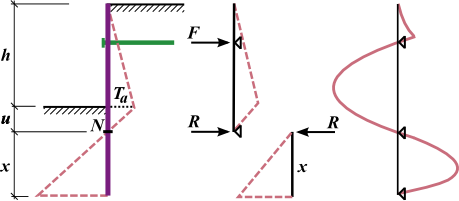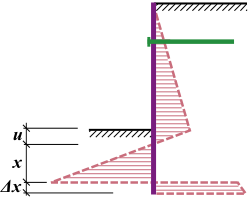Analysis of Anchored Wall Fixed in Heel
Anchored wall fixed in the heel is analyzed as a continuous beam using the deformation variant of the finite element method in order to comply with the assumption of heel fixed in the soil. The actual analysis is preceded by the determination of load due to earth pressure applied to the structure. The pressure acting on the back of a structure is assumed to be the active pressure, while the front face is loaded by the passive pressure.
The passive pressure can be reduced with the help of the coefficient of reduction of passive pressure. Assuming the actual magnitude of the passive earth pressure provides deformations of the analyzed structure, which cannot usually occur. The actual passive pressure can attain for walls free of deformation the value of pressure at rest as well as all intermediate values up to the value of passive pressure for a fully deformed wall (rotation app. 10 mRad - i.e. deformation 10 mm per 1 m of structure height). Therefore it is reasonable to consider reduced values of the passive earth pressure setting the value of the "Coefficient of reduction of passive pressure" to less than or equal to one. The following values are recommended:
- 0.67 reduces deformations app. by one half
- 0.33 deformations attain approximately twenty percent of their original values
The program offers two options to determine active pressure:
- calculation from input soil parameters, water, surcharge, terrain including the introduction of the minimum dimensioning pressure
- inputting an arbitrary distribution of earth pressure up to the depth of the zero point (this way it is possible to introduce an arbitrary redistribution of earth pressure)
Zero-value point, i.e. the point at which the overall pressure equals zero is determined by the following expression:
![]()
where: | u | - | depth of the zero-value point |
σa | - | magnitude of the active pressure behind the structure at the ditch bottom | |
K | - | coefficient of the overall pressure | |
γ | - | unit weight of the soil below the ditch bottom |
The analysis of structure fixed at heel assumes that the point of zero load N (at depth u) is identical with the point of zero moment. For the actual analysis the structure is divided into two parts - an upper part (upper beam) up to the zero-value point and a lower beam:
 Analysis of anchored wall fixed in heel
Analysis of anchored wall fixed in heel
The upper beam is analyzed first together with the evaluation of anchor forces F and the reaction force R at the zero-value point. Then, the lower beam length x is determined such that the moment equilibrium condition with respect to the heel is satisfied (the beam is loaded by the reaction R and by the difference of earth pressures). To satisfy the shear force equilibrium the computed length of the fixed end is extended by the value Δx as shown in the figure:
 Determination of the extension of the length of the wall by Δx
Determination of the extension of the length of the wall by Δx